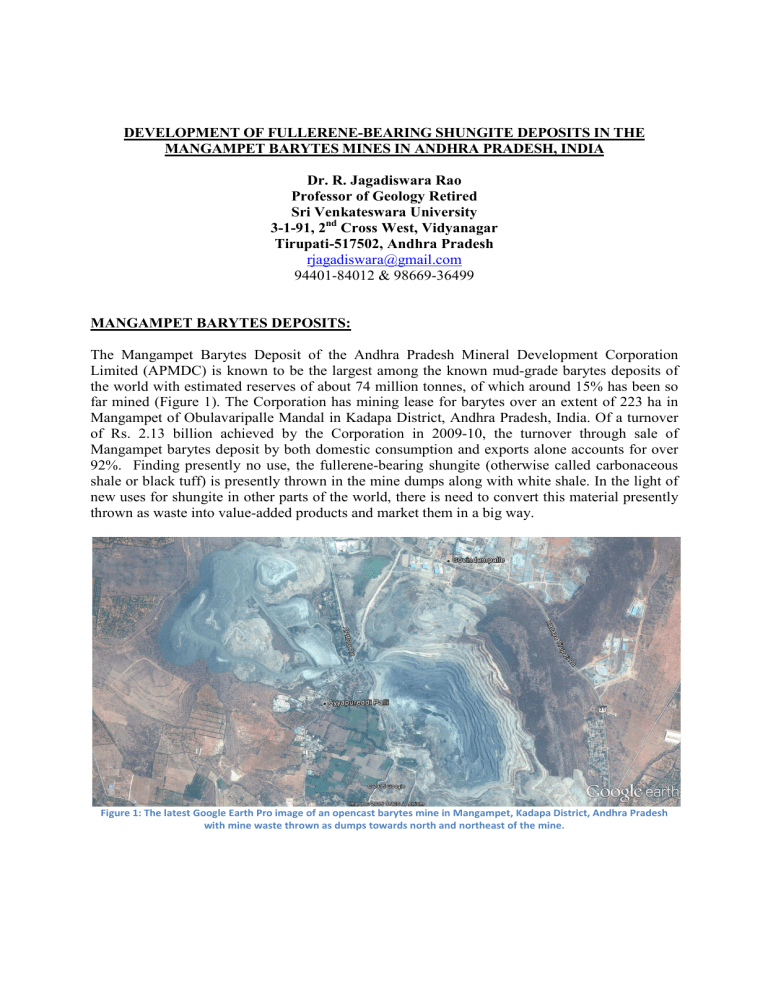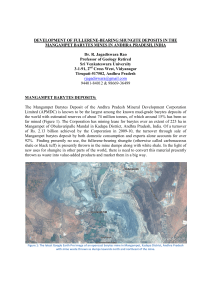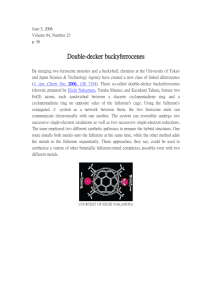
DEVELOPMENT OF FULLERENE-BEARING SHUNGITE DEPOSITS IN THE MANGAMPET BARYTES MINES IN ANDHRA PRADESH, INDIA Dr. R. Jagadiswara Rao Professor of Geology Retired Sri Venkateswara University 3-1-91, 2nd Cross West, Vidyanagar Tirupati-517502, Andhra Pradesh rjagadiswara@gmail.com 94401-84012 & 98669-36499 MANGAMPET BARYTES DEPOSITS: The Mangampet Barytes Deposit of the Andhra Pradesh Mineral Development Corporation Limited (APMDC) is known to be the largest among the known mud-grade barytes deposits of the world with estimated reserves of about 74 million tonnes, of which around 15% has been so far mined (Figure 1). The Corporation has mining lease for barytes over an extent of 223 ha in Mangampet of Obulavaripalle Mandal in Kadapa District, Andhra Pradesh, India. Of a turnover of Rs. 2.13 billion achieved by the Corporation in 2009-10, the turnover through sale of Mangampet barytes deposit by both domestic consumption and exports alone accounts for over 92%. Finding presently no use, the fullerene-bearing shungite (otherwise called carbonaceous shale or black tuff) is presently thrown in the mine dumps along with white shale. In the light of new uses for shungite in other parts of the world, there is need to convert this material presently thrown as waste into value-added products and market them in a big way. Figure 1: The latest Google Earth Pro image of an opencast barytes mine in Mangampet, Kadapa District, Andhra Pradesh with mine waste thrown as dumps towards north and northeast of the mine. SHUNGITE DEPOSITS OF RUSSIA AND KAZAKHSTAN: Millions of tonnes of fullerene-bearing carbonaceous shungite deposits occur in the 2000-million year old rocks of Proterozoic Age in the vicinity of Lake Onega in Karelia Republic of Russia and Almaty Region in Kazakhstan, which possess unusual physical, chemical, physicochemical and technological properties for diverse applications. Koksu Mining Co of Kazakhstan and Carbon-Shungit Ltd of Russia are two private companies, which virtually monopolise mining, processing, research, and development and marketing of processed shungite in those countries for internal consumption as well as for export to European and Asian countries. Processed shungite is used for a variety of purposes, including filler in tyres, rubbers and plastics, water treatment, remediation of solid wastes and wastewaters of biological, agricultural and industrial origin, reclamation of alkaline soils, soil stabilisation, enhancement of soil moisture and fertility, increased plant growth and enhancement of crop yields, manufacture of feed additives, paints, ferro-alloys, and silicon carbide, medicine, and decontamination of mercury, oil spills and rocket fuels. The present sale value of shungite marketed is much more than the income obtained by the APMDC from Mangampet barytes. By finding use to the fullerene-bearing shungite, there can be a phenomenal increase in the income of the Corporation. DISCOVERY OF FULLERENES Three scientists of Rice University in USA and University of Sussex in UK have synthesized fullerene (C60) in 1985 – a new form of carbon consisting of hollow cages of high symmetry and high stability with unusual properties – fetching them the 1996 Nobel Prize in Chemistry. The main property of fullerene is that the extremely stable hollow cages in its structures trap permanently trillions of particles in the size of a fraction of nanometer such as atoms and viruses. Recent work particularly in USA on pure derivatives of fullerenes such as C60, C70, and C84 synthesised from pure carbon soot has led to development of new fields of science such as nanochemistry, astrochemistry, superconductivity, and materials science. This is because of the nano-tube structures of fullerenes, with voids as small as atoms for trapping them permanently in their structures. A few companies in USA produce fullerenes on a small scale at high capital and recurring cost to synthesise highly purified fullerene derivates. No effort has been so far made to produce fullerenes from shungite owing to lack of technology. If this could be achieved, fullerenes could be produced on a large scale from Mangampet shungite in an effective manner. Figure 2 shows atomic structures of different carbon forms – graphite, carbine, diamond, fullerene, shungite and nano-tube. Figure 2: Different forms of Carbon DISCOVERY OF FULLERENE-BEARING SHUNGITE IN MANGAMPET BARYTES MINES: With the publication of a research paper in the Bangalore-based Journal of Geological Society of India in 2007 by a number of scientists from Geological Survey of India of Nagpur and Hyderabad, Stanford University and Cihergen Biosystems of San Francisco, Department of Airborne Mineral Surveys & Exploration (AMSE) of Bangalore and Jaipur, Pune University and National Geophysical Research Institute (NGRI) of Hyderabad, India became the third country in the world to have millions of tonnes of shungite in the 2000-million year old Mangampet Barytes Deposits of Proterozoic age under the possession of the APMDC. The work of Dr. Y. Sreedhar Murthy, Former Professor of Osmania University and CEO of GeoResources Technologies consultants Pvt. Ltd with a grant provided by the DMRTUF Trust of the Government of Andhra Pradesh revealed that fullerene in Mangampet shungite fetches a value higher than that of gold if only techniques could be evolved to isolate from it fullerene derivatives in the purest form. Of the five Mangampet shungite samples he got analysed in the laboratories of Nano-C, Inc at Westwood, MA in USA – a reputed company synthesising highpurity fullerene derivatives from carbon soot, one shungite sample (labelled S7-OB-5) gave an unusually high concentration of 789 gm/ton of C60, 430 gm/ton of C70, and 15.6 gm/ton of C84, while other samples gave consistently low values. When I contacted Dr. Viktor Vejins, President and CEO of Nano-C, he expressed the opinion that it would be worthwhile to take up research and development to isolate high-purity fullerenes from such high-grade shungites. Mr. H.D. Nagaraja, Technical Director of the APMDC expressed that using certain morphological characteristics; this high-grade shungite could be distinguished and separated from the low-grade shungite in the Mangampet mine dumps. While putting shungite into use in the way it was done by Russia and Kazakhstan, it would be worthwhile to separate high-grade Mangampet shungite to obtain highpurity fullerene derivatives. In response to a global notification made by the APMDC seeking expression of interest to develop Mangampet fullerene, the APMDC has identified eleven prospective bidders (viz., Alkali Metals Ltd of Hyderabad, AMR Constructions Ltd of Hyderabad, Dhansar Engineering Co Pvt. Ltd of Kolkata, Hindustan Dorr Oliver Ltd of Mumbai, IBC Ltd of Chennai, Nagarjuna Constructions Co Ltd of Hyderabad, PLR Projects Pvt. Ltd of Hyderabad, Ramgad Minerals & Mining Ltd of Hospet, Ras Natural Resources Pvt. Ltd of Hyderabad, Sushee Hi-Tech Constructions Pvt. Ltd of Hyderabad and Trimex Industries (P) Ltd of Chennai) in their website. The companies in Kazakhstan and Russia, who are hard pressed for capital to develop even their own deposits, are reluctant to develop the Indian deposit as it can even pose a threat to their business. The global notification has not created interest among the American companies engaged in the synthesis of purest fullerene derivatives from carbon soot as their technical knowhow is completely different from that required to isolate purest fullerene derivatives from rocks containing fullerene. A two-year Operation Fullerene Project by the Geological Survey of India (GSI) at Hyderabad in 2010 who depended on a Bangalore-based laboratory for fullerene analysis ended up with a disappointed note that fullerene is absent in the Mangampet black shale. The GSI report however mentions that had they got access to analytical facilities such as available in Nano-C, they would have achieved success. WORK TO BE CARRIED: There is urgent need to take up research and development on a big scale for the effective utilisation of millions of tonnes of shungite obtained and being obtained during mining of Mangampet mud-grade bartytes and presently thrown as waste in the mine dumps. It may be noted that even Koksu Mining Co established under private sector in Kazakhstan had to spend over six million US $ between 2003-2008 to make mining, processing, and marketing of various shungite products viable and productive. Similar efforts should be made for the effective use of Mangampet fullerene-bearing shungite in the way Russia and Kazakhstan have been using their shungite deposits for a variety of uses and in the way certain American companies have been synthesising fullerene derivates from carbon soot for using in the emerging fields of nanochemistry, astrochemistry, superconductivity, and materials science.

